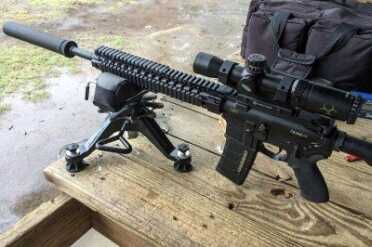
For all testing, I used the same rifle – this Daniel Defense DDM4v5 300 AAC Blackout equipped with a SilencerCo / SWR Specwar 762 suppressor. It’s shown here with a Weaver Kaspa-Z optic.
Recently when I wrote a review of the Daniel Defense DDM4v5 300 Blackout rifle, I mentioned that I’d be doing a drill down series on different aspects of the 300 AAC Blackout. Well, it starts here.
Love it or hate it, the 300 AAC Blackout is an interesting and incredibly diverse cartridge. Imagine trying to design a ballistic compensation scope for a cartridge that can use 110 grain projectiles traveling at 2,400 feet per second AND 245 grain projectiles traveling at 950 feet per second. That last one is somewhat like throwing a brick with much vigor.
This is going to be fun. Let’s dig in with some talk about the cartridge, basic ballistics and reloading for the 300 AAC Blackout.
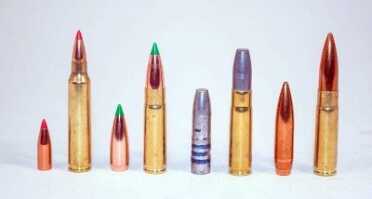
Celebrate diversity! 125, 245 and 220 grain projectiles, left to right. A 55 grain .223 Remington load is shown on the far left for scale.
The physics ’n math stuff
I’m a professional goofball, so I never really got physics. I made it through, but I never really understood concepts like acceleration, momentum and why mass is different than weight. So when it comes to looking at cartridge energy and recoil figures, I always rely on my friend Andrew Chamberlain. He apparently did get physics and he really likes guns. He likes both topics so much that he wrote the Cartridge Comparison Guide. In that book, you can compare pretty much anything about any cartridge to anything else about any other cartridge. If you’re a gun geek, get a copy!
If you do a rough comparison of muzzle energy of the 300 AAC Blackout to the 7.62×39 (AK-47) round, you’ll see a slight edge to the AK with a 100 grain bullet. The 110 grain Blackout at 2,375 feet per second yields 1,377.4 foot-pounds of muzzle energy to the AK’s 1,650.8 at 2,600 feet per second. When it comes to recoil energy, assuming you’re using an 8 pound rifle, the Blackout hits you less with 4.3 foot-pounds compared to the AK’s 6.34 foot-pounds.
But the 300 AAC Blackout isn’t supposed to compete directly with the AK. It’s supposed to offer a .30 caliber alternative with more short barrel terminal performance than the .223 Remington round. If you look at the “standard” 55 grain .223 Remington at 3,240 feet per second, that yields 1,281.8 foot-pounds of muzzle energy and 3.16 foot-pounds of recoil energy. And the Blackout makes a bigger hole.
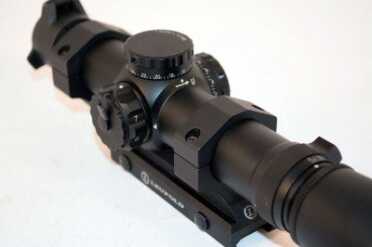
I used the Leupold Mark 4 MR/T 1.5-5×20 scope for all accuracy testing. It features a calibrated ballistic compensation reticle for supersonic and subsonic rounds. It’s a great option for a 300 Blackout rifle.
Shoots flat enough OR like a brick!
We’ve already hinted at the incredibly broad range of bullet weight and velocity that can be successfully fired from the same gun. Want supersonic? No problem. Buy some 100 or 125 grain ammo that will move along at up to 2,400 feet per second. Feel like something more moderate? No problem. .30 caliber bullets are available in all weights. You can get something in the 150 to 168 grain range that will move in the 1,700 to 2,000 feet per second range. Or you can get crazy and go full subsonic from the same AR platform rifle. How about a 208, 220 or even 245 grain projectile moving at 1,000 feet per second or less?
Of course, all of these options will have incredibly diverse trajectories, and that’s what gives scope makers fits over the 300 AAC Blackout. We’ll talk about that in detail next week. For now, let’s just look at bullet drop. We’ll consider scope adjustment for a 50 yard zero range using an optic that is 2.5 inches above the bore.
On the supersonic side, let’s compare bullet drop of a “300 Blackout specific” projectile like the Barnes TAC-TX 110 grain bullet to a 55 grain .223 Remington projectile traveling at 3,240 feet per second.
300 AAC Blackout 110 Grain Barnes TAC-TX, 2,350 fps .223 Remington 55 grain, 3,100 fps
100 yards +0.73 +1.57
200 yards -4.18 +1.43
300 yards -19.77 -4.16
400 yards -49.55 -16.87
500 yards -98.14 -39.06
When it comes to subsonic performance, the 300 AAC Blackout has no direct competitor. Like I said, it’s a thrown brick. But it’s insanely cool, quiet and useful at ranges of 100 yards or less. If you look at the trajectory of a 220 grain Sierra MatchKing fired at 1,023 feet per second, also zeroed at 50 yards, you’ll see the following.
300 AAC Blackout 220 Grain Sierra MatchKing, 2,350 fps
100 yards -6.09
150 yards -21.06
200 yards -45.21
500 yards -399.13
Clearly the subsonic loadings are not intended for long range use, although it might serve as an exceptionally lightweight mortar.

Some of the powders I’ve used in both super and subsonic 300 AAC Blackout loads. The one missing from this photo is Accurate 1680 which is an excellent all around solution for 300 Blackout.
Adventures in reloading!
If you reload ammunition, getting a 300 AAC Blackout rifle may very well ruin your family life. There’s entirely too much tinkering potential. With the broad range of bullet weights and velocities, you may never settle on your own standard load.
I’ve only recently started tinkering with 300 Blackout loads and have already loaded and tested over 40 different projectile, powder and charge combinations, and I’m just getting started.
To narrow things down, lets talk about ideal projectiles and powders. First, you need to find projectiles compatible with .223 magazines. The ribs on .223 magazines are sized to support the necks on .223 / 5.56mm cartridge cases. Since the 300 AAC Blackout uses a cut down case, the ribs will be supporting the bullet itself, so the projectile has to be consistent with the expected dimensions, else feeding reliability will suffer.
Generally speaking, long, pointy bullets seem to work best. If the bullets are too short, feeding can be problematic. If they are too large in diameter at the position of the magazine ribs, feeding can also be impacted.
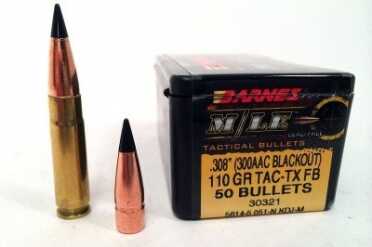
This Barnes TAC-TX 110 grain projectile is made specifically for 300 AAC Blackout. Not the long skinny profile for magazine feeding reliability.
The Barnes TAC-TX is a perfect example of a projectile designed specifically for the 300 AAC Blackout. It’s on the lighter side of the range of 300 AAC Blackout bullets, so it’s intended for the higher end supersonic performance. I’ve also has near perfect success with Sierra MatchKing bullets in 125 and 135 grain weights. 125 grain Nosler Ballistic Tips and 125 grain Hornady SST bullets are also a great 300 Blackout solution.
In terms of powder choices, you’ll use powders in the faster half of the burn rate spectrum, like H110, Lil Gun, Accurate 1680 and IMR 4227. Fortunately, most of these are readily available. Accurate 1680 seems to the best option for subsonic loads as it creates more gas volume for reliable cycling. Unfortunately, that’s the one near impossible to find recently.
Brass availability depends on your desire to be industrious. By design, the cartridge case is identical to that at the .223 Remington, with the exception of being trimmed to a shorter length and reshaped to fit the .30 caliber bullet. You can buy ready-to-go 300 Blackout brass or you can make your own from .223 brass. The process is too much to go into here, but it’s not that big a deal.
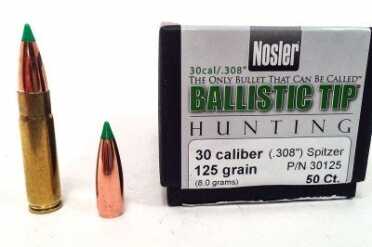
Here’s another good all around bullet for 300 AAC Blackout. The 125 grain Nosler Ballistic Tip is a great hunting round and performed very well in numerous loads for accuracy.
Accuracy and velocity tinkering
Tinkering is the key word here, as performing a methodical approach to determine the most accurate combinations of loads would take centuries. Do the math to calculate the total number of combinations of:
• A half dozen primer types
• A half dozen powder types
• 10 or 12 powder quantities for each type of powder
• A couple of dozen projectile weights
• Minute variations in bullet seating depth
Let’s see… dozens, times dozens, times dozens carry the one… I count 17 billion load combinations required to do a full velocity and accuracy analysis. That wasn’t feasible in my time frame, plus in have a short attention span, so I made a bunch of loads with somewhat impulsive combinations of bullets, powder and charge. I used CCI 400 small rifle primers for all of them to cut out at least one variable. Here’s what I found.

Considering how the subsonic bullets are lobbed rather than fired, one of the accuracy surprised was this 220 grain Sierra MatchKing load. Just over 1 inch at 100 yards!
But first, NEVER, EVER, EVER RELY ON LOAD DATA FROM SECONDHAND SOURCES LIKE THIS ARTICLE. Only use load data from a printed manual from a reputable manufacturer. I’m only sharing this load information here for illustrative purposes to point out the diversity of the 300 AAC Blackout. I can’t be responsible for typos or other errors here. When reloading, always obtain your load data directly from the source. Safety first folks!
All groups in the table below reflect 3 shots and are shown in minutes of angle. If you’re not familiar with that, a minute of angle is just over one inch at 100 yards, so, for example, 1.5 MOA is just about a 1.5 inch group at 100 yards.
For the testing rifle, I used a Daniel Defense DDM4v5 300 AAC Blackout. I reviewed this rifle at the beginning of this series – you can read about it here. I used a Leupold Mark 4 MR/T 1.5-5x20mm optic for all accuracy testing.
Projectile Powder Charge (grains) Average Velocity (feet per second) Group size, MOA
110 grain Barnes TAC-TX H110 19.5 2,377 1.0
125 graIn Sierra MatchKing H110 18.0 2,146 0.94
125 grain Nosler Ballistic Tip IMR 4227 17.5 1,971 1.42
125 grain Hornady SST IMR 4227 18.3 2,085 1.3
125 grain Nosler Ballistic Tip H110 17.5 2,150 1.37
125 grain Nosler Ballistic Tip Lil’ Gun 17.5 2,198 1.74
135 Grain Sierra MatchKing H110 18.2 2,135 1.12
135 Grain Sierra MatchKing IMR 4227 18.3 2,075 N/A
135 Grain Sierra MatchKing Lil’ Gun 17.5 2,093 1.42
150 grain Sierra MatchKing Lil’ Gun 16.0 1,922 1.86
168 grain Sierra MatchKing Lil’ Gun 14.8 1,799 1.56
220 grain Sierra Matchking Lil’ Gun 9.0 1,149 1.1
245 grain lead RNFP IMR 4227 8.8 1,033 N/A
245 grain lead RNFP H110 8.6 1,107 N/A
Just for kicks, I tested a few factory loads for velocity and accuracy too:
Load Velocity (feet per second) Accuracy (MOA)
110 grain Hornady V-MAX 2,435 2.45
208 grain Gorilla Ammunition (A-MAX) 1,038 1.52
245 grain Cooper Cartridge Hard Cast 1,058 N/A
As you can see, you could spend the rest of your life testing different iterations within this caliber. I didn’t do any type of formal ladder testing with powder charge increments and I didn’t even get into varying primer types and seating depth.

The 125 and 135 grain Sierra MatchKing bullets gave excellent accuracy performance. I tried the 110 grain Sierra Varminter hollow point just for fun, but the short profile gave me feeding problems in a couple of loads.
The bottom line
One of the biggest complaints about the 300 AAC Blackout cartridge is the cost and limited availability of factory ammunition. It’s more expensive than .223 / 5.56mm and much harder to find. I get that. But I also don’t see the 300 AAC Blackout as an either / or replacement for .223. It’s a different caliber with its own merits.
On the other hand, if you’re a reloader, it’s a tinkerer’s paradise. If you get crafty and learn how to cut down your own brass from .223 Remington cases, you have an infinite supply of cheap brass. Projectiles are also readily available as .308 inch diameter bullets are used in all sorts of rifles.
The bottom line? Celebrate diversity and try it out! We have more to come on the 300, so stay tuned.

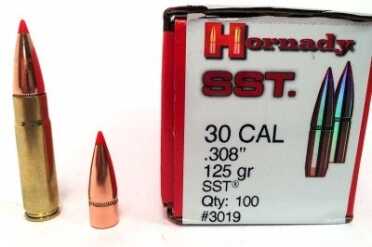
Why can’t you use H110 in 223 reloading
You need to correct: “300 AAC Blackout 220 Grain Sierra MatchKing, 2,350 fps” to the proper fps of ~1K or so, otherwise it doesn’t make subsonic sense.
Have made 300 blk brass from once fired 5.56 stuff. Possibly excellent for plinking use, but have been unable to get consistent accuracy with it. The possible reason being, without going to the time/trouble of annealing the cut off brass, bullet tension has to be suspect. Additionally, mixed military, once fired, brass has a similar result. You can sort the brass, but most acquired examples of LC head stamps have date stamps covering several years – you can spend days just putting together a reasonable amount of like years, and still not have batch consistency. As this author has shown, achieving those MOA groups, so many brag of, even with a full length barrel is problematic in the 300 blk. Our 10.5 SBR hovers around 2″ groups @100 yds, and grey hairs are multiplying in attempts at reducing that number!
I WISH people would LEARN HOW to convey a logical and understandable message…
So I plan to give reloading the 300 AAC a shot. I have a 10.5″ barrel on a pistol that I plan to shoot supersonic only (for now) I have a Dillon 550 press with limited experience reloading .223 rounds for my AR. I want to use Hornady 150gr BTSP bullets, but can’t find any data to support that. Experience tells me the 550 press prefers a ball type powder. Any idea where to start?
Here in S.C. To hunt coyotes at night you have to use a sub sonic round. I’m currently shooting a. speedy 125 g and hitting targets consistently at 350 yards I was wondering if someone had a suggestion for subsonic rounds for my 300 blackout I haven’t tried any yet but I am up for suggestions so I won’t be purchasing many different types of rounds
I own 2 different 300blk now. One 16″ rifle and a 10.5″ pistol both are carbine length gas systems. Shooting off the shelf 125gr bullets the two guns shoot just fine averaging 2050fps and 1960fps repectively.
I’ve started reloading using one shot brass, cci primers and Lil’gun powder. My results are as much as 700fps slower than the books say they should be. Any ideas what I’m missing?
I’m just north of Sandpoint, Idaho and at 2300 foot elevation I’ve found my suppressor works well on a warm (80+deg) day with loads upto 1140 fps, so don’t forget the elevation factor in “local conditions”.
Hi All!
Using DDM4 300 BO. Having no suppresser, a whole lot of Sub sonic miss feeds.
I located 8 x 1 lb of IMR 4227 Power, 500 Berger 210 gr. VDL., & 500 Missouri Bullet 245 gr. FP Hard lead.
Loaded 13.3 gr 4227 and CCI 400 primers with Berger 210 gr. VDL.
Range is only 25 yards, but firing 3 – 4 30 round mags w/o misfire or misfeed was a real blast.
( Zeroed in Red Dot as well )
Loaded 13.3 gr 4227 and CCI 400 primers with 245 gr Missouri Bullet FP Hard Lead.
Pattern was tight but down and to the left about 3 inches. I can see the drop, but to the Left ? ?
Yes! Lead Fouling was a problem as 245 gr Missouri Bullet is .309 Diam.
Will double “peel” by loading in resized .300 brass and using, an arbor press , Push all the way down.
Bullet Puller next. Repeat using freshly Resized Brass.
Maybe Copper plate! Hava a few lbs. of Copper Sulfate on hand. [ Not Rocket Science ]
Anybody use “Dyna Puff” [ A dacron Coarse Power ] Powder Buffer/Case Filler? Supposed to help reduce Lead Fouling.
Thanks for reading.
Kukunet
I have 2 300blk rifles an AR and a 700 aac-sd. I’ve been working with different loads and testing accuracy. Out of my AR 1/8 the 150gr sst 16.0 gr h110 is really accurate and my go to for hogs and deer as a brush gun. The aac-sd with 110gr Sierra varmint bullets will shoot a clover leaf group but with that being said the 300blk is the most temp sensitive cartridge I’ve ever fired I’ll stick with 6.8 for deer. Love my 300blk it’s not perfect
I am from the generation were we salvaged/recycled everything. The one thing that I HATED to do was to scrap .223 Rem/5.56 NATO brass because it was too short, deformed, or the neck split!
Along came the .300 AAC Blackout = the answer to my angst of scraping that brass! Red X arms (redxarms.com) has a complete A4 carbine length upper (minus the bolt carrier group and charging handle) (at the time it cost) for $390 including shipping! I bought that, a Model 1 Sales chrome BCG & charging handle, and a set of Lee Pacesetter .300 AAC Blackout dies (because they were the only ones I could find in stock) and proceeded on my adventure.
I have mixed feelings about the Lee die set. The initial cost makes them look less expensive BUT in the end, after having to buy a separate expander die (IMHO, you need an expander die as it makes placing the bullet into the case a no brainer) and crimp die (the seat dies was says it crimps but, IMHO, it doesn’t do it very well), they cost as much as a Redding or RCBS die set.
NOTE: YOU ABSOLUTELY UNCONDITIONALLY HAVE TO HAVE A CASE GAGE! NOTHING is more frustrating than rounds that WILL NOT allow the bolt carrier to go to battery!
But I digress.
Now that I had a good working set of dies, and about 500 .223 Rem/5.56 NATO cases resized to .300 AAC Blackout, next was to find what my Red X arms “loved”. I have one (more) opinion about firearms: they are like people = they too have their likes and dislikes.
My Red X arms .300 AAC Blackout LOVES Hornady V-Max 110 grain bullets loaded with Lil’ Gun powder. The Hodgdon reloading data center said to load from 18.9 to 20 grains of Lil’ Gun so I loaded five rounds in .1 increments and headed to the range. It shot the best group with the “middle of the road” powder load of 19.5 grains.
I’ve tested many other rounds through my Red X .300 AAC Blackout upper and some work OK but none as well as the Hornady V-Max 110 grain bullets. BUT you may find that YOUR firearm may love another bullet and powder combination as again, each firearm has it’s love/hate relationship with ammo.
As a footnote, my opinion of the .300 AAC Blackout round is that it is the .22S (short) version of the .308 Winchester/7.62 NATO round. A .22LR (long rifle) may have more velocity/hitting power) than a .22S (short) but it’s that same bullet/projectile. The same goes for the .300 AAC Blackout when compared to the .308 Winchester/7.62 NATO round = it’s the same bullet/projectile with a little less hitting power (but not, IMHO, much less!).
This comparison to the AK comes up all the time; but really it shouldn’t. First I don’t know where or who sells 100 grain for Ak’s all mine are 123 grain and winchester is making a 140 hollow point! Finally can’t find 300Ac or afford it. AK on the shelf at every Walmart!
.300 also gets compared to 30-30.
The problem is that the comparisons do not use the same barrel lengths. AK and 300BLK are pretty much identical at 16″ with ~125gr projectiles. And in shorter barrel lengths (~8″) the 300BLK is far superior for supersonics, at least.
Long barrel 300BLK is near pointless IMO, you can find other rounds that outperform it handily in the same platform, with same length barrels.
I find the 300 BO to be just a glorified 7.62×38 round They run so close together they could be faternal twins. That opinion being said is there any reason that loading data for the 300 BO can not be used and worked up on the 7.62×39?
For the shooter you can’t beat the cost per round of the X39 with all of the Mil surplus ammo that is available. Reloadable boxer brass is also in abundance.
Rog
Ballistically they are similar but the case dimensions are very different and load data cannot be reliably interchanged. Stick with published data only, the only exception is it is safe to reduce charges by up to 20% on your own, unless you are loading a large capacity case with a slow burning powder, that is the only situation you need to worry about squibs.
I find the 300 BO to be just a glorified 7.62×38 round They run so close together they could be faternal twins. That opinion being said is there any reason that loading data for the 300 BO can not be used and worked up on the 7.62×39?
For the shooter you can’t beat the cost per round of the X39 with all of the Mil surplus ammo that is available. Reloadable boxer brass is also in abundance.
Rog
I love my DDM4V7 in .300 BLK with a mid-length gas system. It has digested all rounds I have put through it without one hiccup. Supersonic or subsonic, suppressed or not, it has never failed to cycle. Like others, I have not put one factory round through it yet. Love tinkering with different bullets and powders. Even adapted a supersonic load using WC820 from the .30 carbine. Great carbine in a great caliber!!
I’m guessing you made the assumption that all 300AAC barrels has a pistol length gas tube, because you didn’t mention gas tubes. With a carbine length tube, the 300aac becomes very finicky.
The one I’ve been using is carbine length. I’ve had a little trouble with some subsonic loads cycling, but have found powder combinations that make it run. So far, all the factory subsonic ammo I’ve tried, with the exception of Cooper Cartridge 245 grain lead bullets, runs fine in this particular carbine length rifle.
Were all these rounds shot suppressed?
Yes – Right after I mounted a suppressor, I tested for before and after groups and the suppressor did not hurt accuracy at all. If anything, average groups tightened up a bit, so I just left it on for all of the testing.
I’m not fortunate enough to be hog hunter so my primary motivation for a .300 Blackout would be for a subsonic suppressed round in a short barrel home defense role, something I have considered building myself just for the exercise. I am a reloader and these days I shoot to reload rather than reload to shoot so the development aspect appeals to me to a point.
Recently I am gravitating to the Clint Smith theory of cartridge, gun and reloading; that is the one caliber, one load, one gun MO in order to simplify inventories, procedures, lower costs and increase fun time. As an old Marine my bred in need for perfection is giving way to practicality, less obsession and more fun. In this vein, I have settled on one powder for the .556 – Hodgdon’s CFE 223 which I was fortunate enough to find a supply of shortly after it first became available and am hoping to do the same with their CFE Pistol if I can ever find any.
If a single powder and projectile primarily for subsonic loads turns out to work for .300 Blackout that would be great. If it turned out to that CFE 223 could fill that role that would be the best of all worlds. Given the opportunity I would stick to Hornady bullets, CCI primers and one powder each for most of my long gun and short gun needs. Exceptions would be just that.
I tinker with 300blk., have shot several hundred rounds with various combinations of components. Never had a factory round through it. Yes I agree a tinker’s dream.
I got caught by the tinkering bug on
this round and enjoyed your article.
I shoot the 168 grain .308 out of 30-06 and 308 brass, so I was thinking about using 168 bullet in black out, any thoughts?
You can use anything from 110 to 220 grain with no problem with the .300AAC. The higher the grain the quieter the round when suppressed. The lower the grain the faster the round and the harder it hits. Check out: http://www.gunbot.net and search .300aac or blackout and you will see a wide variety of different grain weights for sale.
As long you know what you want the weight / velocity combination for, those work really well. I’ve shot a bunch of 168 grain Sierra MatchKings and it’s a great plinking / target round. For hunting, I would ask others to chime in, but if you have a 168 grain bullet that is designed to perform at the velocity you’re going to get, that should be an option too.
FYI . “Things” don’t like to travel at or close to the speed of sound ! I’m thinking that your loads that are N/A are such. Sound speed is 1087 @ 32 degrees Fahrenheit . Keep your loads at least 100fps up or down sound speed and they will be more accurate . Good luck! Tom. [email protected]
Confession time…. I forgot to measure before destroying the targets on those! Doh!
Interesting.
When I first got my 300 BO, I was looking for Lil, Gun couldn’t; find it, so ordered 1 lb of IMR4227 for the BO. Later I got the 6 lbs of H110 from a guy on Backpage and I had Thunderbird T680 (military version of AA1680) already for subsonics (it is about perfect for 30 C Carbine too which is what I used it for originally)
Interesting.
When I first got my 300 BO, I was looking for Lil, Gun couldn’t; find it, so ordered 1 lb of IMR4227 for the BO. Later I got the 6 lbs of H110 from a guy on Backpage and I had Thunderbird T680 (military version of AA1680) already for subsonics (it is about perfect for 30 C Carbine too which is what I used it for originally)
Speed of sound or Mach 1.0 is 1115 fps at standard conditions of 59F and 29.92 inches of mercury. The formula is 1088 (some use 1087) fps + (F-32). At standard conditions, 59F and 29.92,” 1088 + (59-32)= 1115 fps. Proper subsonic is usually 0.92 Mach or 1025.8 fps or lower depending on bullet design, bullet yaw beyond the muzzle and of course, accuracy. 950 fps is usually seen as a comfortable sub sonic load. On a hot day, 100F, 1088 + (100-32)= 1156 fps. In cold weather, 10F, 1088 + (10-32)= 1066 fps. Sub zero, -32F, 1088 + (-32+32) = 1088 fps. Someone please check my numbers.
And suppressors can make a bit of a difference, usually an increase in velocity, adding importance to your point of staying well below your “local conditions” speed of sound.